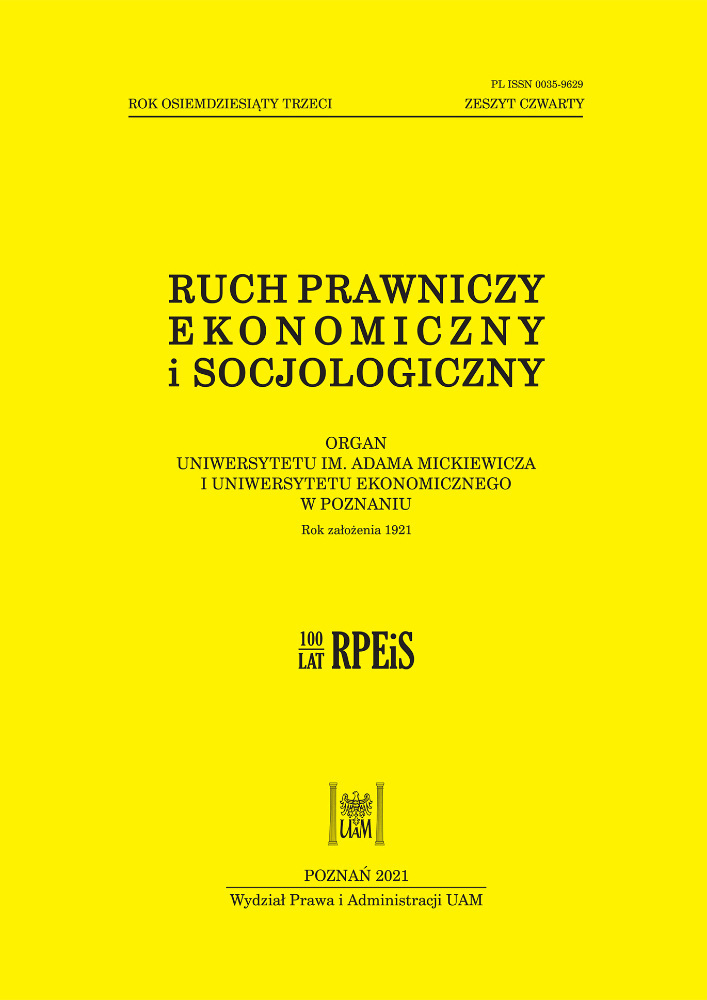Abstract
The numerous studies of risk perception to date have been focused on three different areas of the subject. Firstly, researchers have aimed at the identification of risk perception determinants, secondly, they have created recommendations on how to communicate the risk to society, and finally they have analysed the relationships between risk perception measures and the means of risk control implemented in organizations. The last indicated research area is complemented by the following paper. On the basis of data derived from online interviews it was concluded that the higher the assessment of the measures of environmental insurance risk perception, the more frequently organizations implemented selected means of risk control in the environmental management system according to ISO 14001 (EMS ISO 14001). The largest number of statistically significant dependencies were observed in the area of variables which describe the informative potential of EMS ISO 14001 (informative potential variables) and those which directly determine the volume of environmental insurance risk (the volume of risk variables). Simultaneously, not all categories of risk perception measures are equally related to the frequency of risk control means implementation. A particularly large number of statistically significant correlations were identified for the following variable: the evaluation of the likelihood of the occurrence of environmental damage.
Funding
This research was undertaken as part of the project: Private insurance and environmental management systems complying with ISO 14001 as tools of environmental risk’s management – analysis of relations and was funded by a grant of National Science Centre, Poland (2016/23/D/ HS4/02654).
References
Alhakami, A.S., Slovic, P.A. (1994). Psychological study of the inverse relationship between perceived risk and perceived benefit. Risk Analysis 14: 1085–1096.
Allen, D., Coles, E., Kankaanranta, T., Mcmullan, C., Mobach, D., Norman, A., Perko, T., Pylvas, K., Wijngaards, N. (2017). Good practices and innovation in risk communication, [in:] K. Poljansek (ed.), Science for Disaster Risk Management 2017: Knowing Better and Loosing Less. Brussels: 422–440.
Altonoğlu, B.D., Atav, E., Sönmez, S. (2017). The investigation of environmental risk perception and attitudes towards the environment in secondary school students. The Turkish Online Journal of Educational Technology December: 436–444.
Anantho, S. (2008). Risk Perception and Sustainable Development in Thailand. <https://www.academia.edu/7423455/Risk_Perception_and_Sustainable_Development_in_Thailand>.
Aven, T., Renn O. (2010). Risk Management and Governance. New York.
Bamberg, S., Möser, G. (2007). Twenty years after Hines, Hungerford, and Tomera: a new meta--analysis of psycho-social determinants of pro-environmental behavior. Journal of Environmental Psychology 27: 14–25.
Brewer, N.T., Chapman, G.B., Gerrard, M., Gibbons, F.X., McCaul, K.D. (2007). Meta-analysis of the relationship between risk perception and health behaviour: the example of vaccination. Health Psychology 26(2): 136–145.
Chauvin, B., Hermand, D., Mullet, E. (2007). Risk perception and personality facets. Risk Analysis 27(1): 171–185.
Crawford-Brown, D.J. (1999). Risk-Based Environmental Decisions: Methods and Culture. New York.
Gregory, R., Mendelsohn, R. (1993). Perceived risk, dread, and benefits. Risk Analysis 13: 259–264.
Janmaimool, P., Watanabe, T. (2014). Evaluating determinants of environmental risk perception for risk management in contaminated sites. International Journal of Environmental Research and Public Health 11(6): 6291–6313.
Kaczała, M. (2017). Empirical analysis of farmers’ winterkill risk perception, [in:] J. Nešleha, T. Plíhal, K. Urbanovský (eds.), European Financial Systems 2017. Proceedings of the 14th International Scientific Conference. Brno: 281–289.
Kaczała, M. (2019). Systemowe ryzyko suszy rolniczej a ubezpieczenia. Zadania dla państwa. Poznań.
Kasperson, R. (2014). Four questions for risk communication. Journal of Risk Research 17(10): 1233–1239.
Lash, S., Wynne, B. (1992). Risk Society: Towards a New Modernity. London.
Lemkowska, M. (2020). Systemy zarządzania środowiskowego zgodne z wymaganiami normy ISO 14001 na tle wybranych determinant rozwoju rynku ubezpieczeń środowiskowych. Toruń.
Macias, T. (2016). Environmental risk perception among race and ethnic groups in the United States. Ethnicities 16(1): 111–129.
Michalak, J. (2004). Ryzyko a zagrożenie. Materiały z otwartego zebrania naukowego Katedry Ubezpieczeń Akademii Ekonomicznej w Poznaniu z dnia 19.03.2004 r. Poznań.
O’Connor, R.E., Bord, R.J., Fisher, A. (1999). Risk perceptions, general environmental beliefs, and willingness to address climate change. Risk Analysis 19(3): 461–471.
Otway, H., Thomas, K. (1982). Reflections on risk perception and policy. Risk Analysis 2: 69–82.
Renn, O. (2014). Four questions for risk communication: a response to Roger Kasperson. Journal of Risk Research 17(10): 1277–1281.
Rowe, G.R., Frewer, L.J. (2004). Evaluating public participation exercises: a research agenda. Science. Technology & Human Values October: 512–556.
Sandman, P.M. (2012). Responding to Community Outrage: Strategies for Effective Risk Communication. Falls Church.
Seeger, M.W. (2006). Best practices in crisis communication: an expert panel process. Journal of Applied Communication Research 34(3): 232–244.
Shengxiang, S., Qiang, L., Chaoqun, M. (2012). A probability-time & space trade-off model in environmental risk perception. Journal of Risk Research 15(2): 223–234.
Slovic, P. (1987). Perception of Risk. Science 236(4799): 280–285.
Slovic, P., Fischhoff, B., Lichtenstein, S. (1980). Facts and fears: understanding perceived risk, [in:] R.C. Schwing, W.A. Albers (eds.), Societal Risk Assessment: How Safe Is Safe Enough? New York: 181–214.
Toma, L., Mathijs, E. (2007). Environmental risk perception, environmental concern and propensity to participate in organic farming programmes. Journal of Environmental Management 83: 145–157.
Xu, G., Feng, X., Li, Y., Chen, X., Jia, J. (2017). Environmental risk perception and its influence on well-being. Chinese Management Studies 11(1): 35–50.
License
Copyright (c) 2021 WPiA UAM

This work is licensed under a Creative Commons Attribution-NonCommercial-NoDerivatives 4.0 International License.





